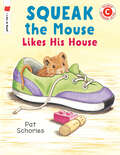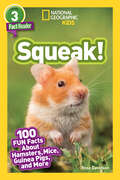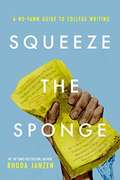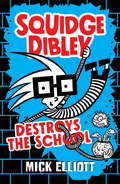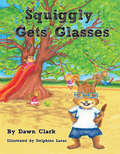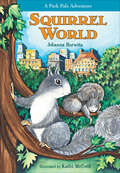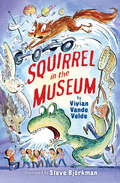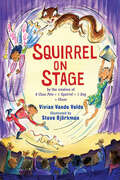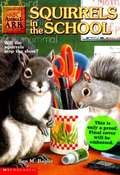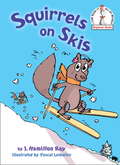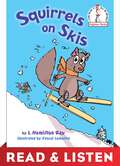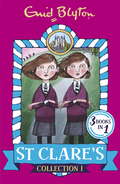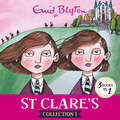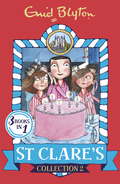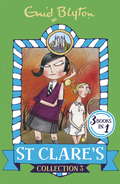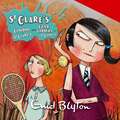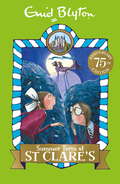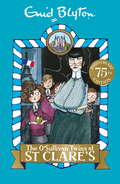- Table View
- List View
Squeak the Mouse Likes His House (I Like to Read)
by Pat SchoriesThe illustrator of the best-selling Biscuit books has created an adorable mouse who inhabits a Borrowers-like world.To a tiny creature like Squeak, a sneaker can become a bed, a toy can become a vehicle, and a few crumbs can become a meal. Readers will be fascinated by the contrast in scale between the giant human world (inhabited by two unsuspecting children) and the diminutive mouse world. As an extra treat, there are fun mazes on the endpapers that follow Squeak's adventure!
Squeak!: 100 Fun Facts About Hamsters, Mice, Guinea Pigs, and More (Readers)
by Rose DavidsonMice and rats may be the most famous rodents, but readers will discover the diverse--and maybe even adorable--world of little squeaking critters. From cavies and capybaras to jerboas and gerbils to pocket mice and porcupines, get ready for the rodents.Packed with weird-but-true facts and tons of animal info, this Level 3 Reader shows just how endearing rodents can be. Meet the adorable pika, fuzzy hamsters, and yes, even supersmart rats, and collect cool facts about these scurrying squeaky creatures. National Geographic Fact Readers feature the same expert-vetted running text as traditional readers--with a bonus of 100 fun facts sprinkled throughout! A fact roundup at the end of each book lets kids review what they've learned. (Plus, they can impress their friends with their animal expertise!)
Squeeze the Sponge: A No-Yawn Guide to College Writing
by Rhoda JanzenThis book uses the author’s powerful, hilarious, and emotionally generous voice as a bestselling memoirist and award-winning professor to offer undergraduate students an inspirational writing guide. This indispensable textbook is replete with hands-on activities, seventy pages of grammar instruction, and memorable tips, examples, and analogies to help students refine their writing—in other words, “squeeze the sponge.” In this book, the author achieves something new: a textbook so lively and humorous that students will actually want to read it.
Squidge Dibley Destroys the School
by Mick ElliottThings are going downhill fast for class 6PU at Craglands South Primary School. They've changed teachers more times than most kids change their socks, and their latest one is so strict they aren't even allowed to sneeze. But just when it seems like the school term has been turned into a prison term, a new kid arrives.A kid unlike any other kid at Craglands South.A kid named Squidge Dibley.He's small, quiet and strangely ... squidgy.And he's about to change everything.Squidge Dibley Destroys the School is book one in a hilarious new series by Mick Elliott, author of The Turners, and features his unforgettable cartoon-style illustrations on every page.
Squiggly Gets Glasses
by Dawn ClarkSquiggly just wants to fit in, but it's hard when he looks so different from the other squirrels at school. And the class bully, Archie, doesn't make it any easier. But, with the help of his good friends and some great adults, Squiggly learns that being different doesn't have to be hard---it can be fun! Squiggly realizes just how special he is, how great making new friends can be, and that he doesn't have to look like anyone else, he just has to look like Squiggly!
Squirrel World (The Pals Park Adventures)
by Johanna Hurwitz&“This solidly written, charmingly illustrated book will appeal to readers clamoring for animal tales&”—from the award-winning author of PeeWee and Plush (Booklist). Squirrels Lexington (Lexi) and Lenox decide to visit the New York City streets they were named after. Lexi is worried about leaving Central Park, but Lenox is confident that their streets will be beautiful places, maybe even better than the park! When the two squirrels venture into the city, they soon realize that the human world is stranger and more dangerous than they&’d ever imagined. This fourth exciting Park Pals tale brings back the fun, adventure, and favorite furry characters that this award-winning series is known for. Praise for the Park Pals Adventure series &“Full of wonderful, subtle thoughts about friendship, bravery and freedom.&” —The Boston Globe &“Chock-full of positive messages . . . Adventure and suspense.&” —School Library Journal &“Appealing . . . Sure to melt even the hardest of hearts.&” —Kirkus Reviews
Squirrel in the Museum (Twitch the Squirrel #3)
by Vivian Vande VeldePandemonium breaks out at the science museum when Twitch the squirrel tags along on a school trip.The fluffy squirrel hero of 8 Class Pets + 1 Squirrel ÷ 1 Dog = Chaos takes his show on the road in this chapter book. When Twitch hears that the school children are taking a field trip to the science museum, he decides he wants to join in the fun--so he stows away on the school bus and hides in a backpack to get in. But as always, not everyone is glad to see a squirrel in their midst. Pursued by security guards, Twitch turns the exhibits into his own private carnival rides--swinging on a Foucault pendulum, riding a model Mars Rover, and skittering across the Bernoulli air pressure table. Just when it seems like there's no escape, Twitch's chaotic romp turns up some surprises for the museum staff. . . . and a friendly boy in a wheelchair saves the day for the squirrel, sneaking him back out. With more than fifty energetic illustrations accompanying the short, hilarious chapters, Squirrel in the Museum is a perfect pick for young readers just starting to seek out longer texts--or a great read-aloud. For aspiring scientists, Squirrel in the Museum also includes an explanation of the scientific exhibits Twitch encounters--as told by the friendly science lab geckos.
Squirrel on Stage (Twitch the Squirrel)
by Vivian Vande VeldeTwitch the lovably chaotic squirrel and Sweetie the Library Rat accidentally make their stage debuts in this hilarious chapter book, a new followup to 8 Class Pets.When Twitch discovers the kids at school are putting on a Cinderella play, he can&’t believe his luck. He loves good stories! But how to watch the play undetected? He convinces friend Sweetie the library rat to join his adventure to the auditorium, but of course it doesn&’t go as planned! Twitch and Sweetie will go behind the curtain and even above stage before the day is over in this fourth book in the celebrated series.With energetic illustrations accompanying the short, hilarious chapters, told from Twitch and Sweetie&’s alternating points of view, Squirrel on Stage is a perfect pick for young readers just starting to seek out longer texts—or a great read-aloud. For aspiring thespians, Squirrel on Stage also includes tips kids can use to put on their own play.
Squirrels in the School (Animal Ark #17)
by Ben M. BaglioWhen a family of squirrels finds its way into Mandy's and James's school, the principal wants to put down poison. Can the kids help the squirrels to safety before it's too late?
Squirrels on Skis (Beginner Books(R))
by Pascal Lemaitre J. Hamilton RayThis new Beginner Book about manic skiing squirrels--by J. Hamilton Ray with illustrations by Pascal Lemaitre--has the feeling of an old classic read-aloud. "Nobody knew how the mania grew. First there was one, and then there were two. Three more came gliding from under the trees. LOOK! On the hill. Those are squirrels on skis! Below lay the town, snow-covered and still. Not a sound could be heard. All was silent, until . . . Swwwishhhh swooped the skiers, all dressed for play. Eighty-five squirrels and more on the way!" As you can imagine, the townsfolk are NOT amused. Can intrepid reporter Sally Sue Breeze find out where the squirrels are getting their skis-and make them stop skiing long enough to eat lunch-before pest-control guy Stanley Powers sucks them up in his vacuum device? (Don't worry--Sally triumphs in a most unexpected way.) With delightfully understated, funny illustrations by Pascal Lemaitre, this is the perfect book for beginning readers to curl up and chill out with on a snow day--or any day!
Squirrels on Skis: Read & Listen Edition (Beginner Books(R))
by J. Hamilton RayThis new Beginner Book about manic skiing squirrels—by J. Hamilton Ray with illustrations by Pascal Lemaitre—has the feeling of an old classic read-aloud. "Nobody knew how the mania grew. First there was one, and then there were two. Three more came gliding from under the trees. LOOK! On the hill. Those are squirrels on skis! Below lay the town, snow-covered and still. Not a sound could be heard. All was silent, until . . . Swwwishhhh swooped the skiers, all dressed for play. Eighty-five squirrels and more on the way!" As you can imagine, the townsfolk are NOT amused. Can intrepid reporter Sally Sue Breeze find out where the squirrels are getting their skis-and make them stop skiing long enough to eat lunch-before pest-control guy Stanley Powers sucks them up in his vacuum device? (Don't worry—Sally triumphs in a most unexpected way.) With delightfully understated, funny illustrations by Pascal Lemaitre, this is the perfect book for beginning readers to curl up and chill out with on a snow day—or any day!Originally created by Dr. Seuss, Beginner Books encourage children to read all by themselves, with simple words and illustrations that give clues to their meaning.This Read & Listen edition contains audio narration.
Srajana Hindi class 12 - RBSE Board: सर्जना हिंदी कक्षा 12 - आरबीएसई बोर्ड
by Madhyamik Shiksha Board Rajasthan Ajmerसर्जना इस पाठ्यपुस्तक मे काव्य खंड के अन्तर्गत संतों की वाणी श्रेष्ठ जीवन मूल्यों को अपनाने की प्रेरणा देती हैं। रहीम के पदों द्वारा लोक-व्यवहार की शिक्षा दी गई है। राष्ट्रीयता की भावना से ओत-प्रोत भूषण के कवित्त प्रेरणादायी हैं। गद्य भाग में विभिन्न विधाओं से परिचित कराते है।
St Clare's Collection 1: Books 1-3 (St Clare's Collections and Gift books)
by Enid BlytonSchooldays at St Clare's are never dull for twins Pat and Isabel O'Sullivan in Enid Blyton's much-loved boarding school series.The twins at St Clare'sPat and Isabel find life at St Clare's is not as easy as they thought. They have several surprises and arguments before they admit their troubles are of their own making, and settle down to make friends.The O'Sullivan Twins at St Clare'sIt's the start of the Easter Term and the twins are looking forward to meeting all their friends at St Clare's once more. They are determined to be obedient and studious, but the new girls prove to be so much fun. Poor Mam'zelle had better watch out.Summer Term at St Clare'sThe twins look forward to their first summer term at St Clare's. They soon make friends with new girl Carlotta, who has a secret past that she's desperate to hide. But sneaky Prudence finds out and tells everybody. How will the class react?There'll be mischief at St Clare's!Between 1941 and 1946, Enid Blyton wrote six novels set at St Clare's. This collection features the original text and is unillustrated.
St Clare's Collection 1: Books 1-3 (St Clare's Collections and Gift books)
by Enid BlytonSchooldays at St Clare's are never dull for twins Pat and Isabel O'Sullivan in Enid Blyton's much-loved boarding school series.The twins at St Clare'sPat and Isabel find life at St Clare's is not as easy as they thought. They have several surprises and arguments before they admit their troubles are of their own making, and settle down to make friends.The O'Sullivan Twins at St Clare'sIt's the start of the Easter Term and the twins are looking forward to meeting all their friends at St Clare's once more. They are determined to be obedient and studious, but the new girls prove to be so much fun. Poor Mam'zelle had better watch out.Summer Term at St Clare'sThe twins look forward to their first summer term at St Clare's. They soon make friends with new girl Carlotta, who has a secret past that she's desperate to hide. But sneaky Prudence finds out and tells everybody. How will the class react?There'll be mischief at St Clare's!Between 1941 and 1946, Enid Blyton wrote six novels set at St Clare's. This collection features the original text and is unillustrated.
St Clare's Collection 1: Books 1-3 (St Clare's Collections and Gift books)
by Enid BlytonSchooldays at St Clare's are never dull for twins Pat and Isabel O'Sullivan in Enid Blyton's much-loved boarding school series.The Twins at St Clare'sPat and Isabel find life at St Clare's is not as easy as they thought. They have several surprises and arguments before they admit their troubles are of their own making, and settle down to make friends.The O'Sullivan Twins at St Clare'sIt's the start of the Easter Term and the twins are looking forward to meeting all their friends at St Clare's once more. They are determined to be obedient and studious, but the new girls prove to be so much fun. Poor Mam'zelle had better watch out.Summer Term at St Clare'sThe twins look forward to their first summer term at St Clare's. They soon make friends with new girl Carlotta, who has a secret past that she's desperate to hide. But sneaky Prudence finds out and tells everybody. How will the class react?There'll be mischief at St Clare's!Between 1941 and 1946, Enid Blyton wrote six novels set at St Clare's. This is an audiobook collection of the first three novels. (P) 2021 Hodder & Stoughton Limited
St Clare's Collection 2: Books 4-6
by Enid BlytonSchooldays at St Clare's are never dull for twins Pat and Isabel O'Sullivan in Enid Blyton's much-loved boarding school series.The Second Form at St Clare'sThe twins have made it to second form. New girls Gladys and Mirabel have great talents for acting and music, and Elsie, the form's unpopular Head Girl, learns to be less spiteful.The Third Form at St Clare'sIt's time for a new head girl. There are plenty of candidates, but after a terrible accident, and an hilarious school play, the true leaders are revealed.Kitty at St Clare'sPat breaks her arm and misses the first weeks of term. Will Pat be upset when new girl Amanda becomes Isabel's new best friend?There'll be mischief at St Clare's!Between 1941 and 1946, Enid Blyton wrote six novels set at St Clare's. Books 5, 6 and 9 are authorised sequels of the series written by Pamela Cox and feature storylines set in between the original Blyton novels. These books were published in 2000/2008 and are unillustrated.
St Clare's Collection 2: Books 4-6 (St Clare's Collections and Gift books)
by Enid BlytonSchooldays at St Clare's are never dull for twins Pat and Isabel O'Sullivan in Enid Blyton's much-loved boarding school series.The Second Form at St Clare'sThe twins have made it to second form. New girls Gladys and Mirabel have great talents for acting and music, and Elsie, the form's unpopular Head Girl, learns to be less spiteful.The Third Form at St Clare'sIt's time for a new head girl. There are plenty of candidates, but after a terrible accident, and an hilarious school play, the true leaders are revealed.Kitty at St Clare'sPat breaks her arm and misses the first weeks of term. Will Pat be upset when new girl Amanda becomes Isabel's new best friend?There'll be mischief at St Clare's!Between 1941 and 1946, Enid Blyton wrote six novels set at St Clare's. Books 5, 6 and 9 are authorised sequels of the series written by Pamela Cox and feature storylines set in between the original Blyton novels. These books were published in 2000/2008 and are unillustrated.
St Clare's Collection 3: Books 7-9
by Enid BlytonSchooldays at St Clare's are never dull for twins Pat and Isabel O'Sullivan in Enid Blyton's much-loved boarding school series.Claudine at St Clare'sEileen's mother is the new Matron and Mam'zelle's niece, Claudine, joins St Clare's and causes havoc wherever she goes. The twins are enchanted by rebellious Claudine and her mad-cap plans, but will she last the term?Fifth Formers of St Clare'sThe girls are in the fifth form, about to reach the sixth, but they are not too old for tricks and escapades, jokes and excitement. Especially amusing is French girl Antoinette who, like her sister Claudine, doesn't always understand the ways of St. Clare's.The Sixth Form at St Clare'sThe unimaginable has happened - the twins made head girl! It's a tough job - cheeky first formers and cruel Priscilla keep the girls on their toes.There'll be mischief at St Clare's!Between 1941 and 1946, Enid Blyton wrote six novels set at St Clare's. Books 5, 6 and 9 are authorised sequels of the series written by Pamela Cox and feature storylines set in between the original Blyton novels. These books were published in 2000/2008 and are unillustrated.
St Clare's Collection 3: Books 7-9 (St Clare's Collections and Gift books)
by Enid BlytonSchooldays at St Clare's are never dull for twins Pat and Isabel O'Sullivan in Enid Blyton's much-loved boarding school series.Claudine at St Clare'sEileen's mother is the new Matron and Mam'zelle's niece, Claudine, joins St Clare's and causes havoc wherever she goes. The twins are enchanted by rebellious Claudine and her mad-cap plans, but will she last the term?Fifth Formers of St Clare'sThe girls are in the fifth form, about to reach the sixth, but they are not too old for tricks and escapades, jokes and excitement. Especially amusing is French girl Antoinette who, like her sister Claudine, doesn't always understand the ways of St. Clare's.The Sixth Form at St Clare'sThe unimaginable has happened - the twins made head girl! It's a tough job - cheeky first formers and cruel Priscilla keep the girls on their toes.There'll be mischief at St Clare's!Between 1941 and 1946, Enid Blyton wrote six novels set at St Clare's. Books 5, 6 and 9 are authorised sequels of the series written by Pamela Cox and feature storylines set in between the original Blyton novels. These books were published in 2000/2008 and are unillustrated.
St Clare's: Claudine at St Clare's & Fifth Formers at St Clare's (St Clare's #1)
by Enid BlytonSchooldays at St Clare's are never dull for twins Pat and Isabel O'Sullivan in Enid Blyton's much-loved boarding school series.Claudine at St Clare's Eileen's mother is the new Matron and Mam'zelle's niece, Claudine, joins St Clare's and causes havoc wherever she goes. The twins are enchanted by rebellious Claudine and her mad-cap plans, but will she last the term?Fifth Formers at St Clare'sThe girls are in the fifth form, about to reach the sixth, but they are not too old for tricks and escapades, jokes and excitement. Especially amusing is French girl Antoinette who, like her sister Claudine, doesn't always understand the ways of St. Clare's.Expect more mischief at St Clare's!Between 1941 and 1946, Enid Blyton wrote six novels set at St Clare's. This audio download is abridged and dramatised with a full cast and makes wonderful listening for all St Clare's fans. Each story is one hour. (P) Hodder Children's Books 2006
St Clare's: Summer Term at St Clare's
by Enid BlytonSchooldays at St Clare's are never dull for twins Pat and Isabel O'Sullivan in Enid Blyton's much-loved boarding school series.In book three, Pat and Isabel look forward to their first summer term at St Clare's. They soon make friends with new girl Carlotta, who has a secret past that she's desperate to hide. But sneaky Prudence finds out and tells everybody. How will the class react?There'll be mischief at St Clare's!Between 1941 and 1946, Enid Blyton wrote six novels set at St Clare's. This edition features the original text and is unillustrated.
St Clare's: Summer Term at St Clare's & The Second Form at St Clare's (St Clare's #1)
by Enid BlytonSchooldays at St Clare's are never dull for twins Pat and Isabel O'Sullivan in Enid Blyton's much-loved boarding school series.Summer Term at St Clare's The twins look forward to their first summer term at St Clare's. They soon make friends with new girl Carlotta, who has a secret past that she's desperate to hide. But sneaky Prudence finds out and tells everybody. How will the class react?The Second Form at St. Clare'sPat and Isabel have made it to second form. New girls Gladys and Mirabel have great talents for acting and music, and Elsie, the form's unpopular Head Girl, learns to be less spiteful.Expect more mischief at St Clare's!Between 1941 and 1946, Enid Blyton wrote six novels set at St Clare's. This audio download is abridged and dramatised with a full cast and makes wonderful listening for all St Clare's fans. Each story is one hour. (P) Hodder Children's Books 2006
St Clare's: The O'Sullivan Twins
by Enid BlytonSchooldays at St Clare's are never dull for twins Pat and Isabel O'Sullivan in Enid Blyton's much-loved boarding school series.In book two, it's the start of the Easter Term and the twins are looking forward to meeting all their friends at St Clare's once more. They are determined to be obedient and studious, but the new girls prove to be so much fun. Poor Mam'zelle had better watch out.Expect mischief at St Clare's!Between 1941 and 1946, Enid Blyton wrote six novels set at St Clare's. This edition features the original text and is unillustrated.
St Clare's: The Twins at St Clare's & The O'Sullivan Twins (St Clare's #1)
by Enid BlytonSchooldays at St Clare's are never dull for twins Pat and Isabel O'Sullivan in Enid Blyton's much-loved boarding school series.The Twins at St Clare's Pat and Isabel find life at St Clare's is not as easy as they thought. They have several surprises and arguments before they admit their troubles are of their own making, and settle down to make friends.The O'Sullivan TwinsIt's the start of the Easter Term and the twins are looking forward to meeting all their friends at St Clare's once more. They are determined to be obedient and studious, but the new girls prove to be so much fun.Poor Mam'zelle had better watch out.Expect mischief at St Clare's!Between 1941 and 1946, Enid Blyton wrote six novels set at St Clare's. This audio download is abridged and dramatised with a full cast and makes wonderful listening for all St Clare's fans. Each story is one hour. (P) Hodder Children's Books 2006
St. Bernadette Soubirous: 1844-1879
by John Joyce Abbé François TrochuST. BERNADETTE SOUBIROUS is a two-fold story: that of the apparition of the Blessed Virgin Mary at Lourdes, France in 1858, as well as of the 14-year-old peasant girl--raised in dire poverty and unable to read--to whom Our Lady appeared. But more, it is also the story of St. Bernadette's hidden life as a seemingly ordinary nun in her convent at Nevers, where she reached such holiness that after her death, God saw fit to preserve her body incorrupt--as it remains to this day!Beautifully set forth in this book are St. Bernadette's childhood and life at home, her character--honest, intelligent and straightforward--her description of Our Lady, the events surrounding the 18 apparitions, the opposition of the civil authorities, and the shrine and miraculous spring at Lourdes. Also described are Bernadette's life in the convent, where she suffered a martyrdom in body and in soul.
